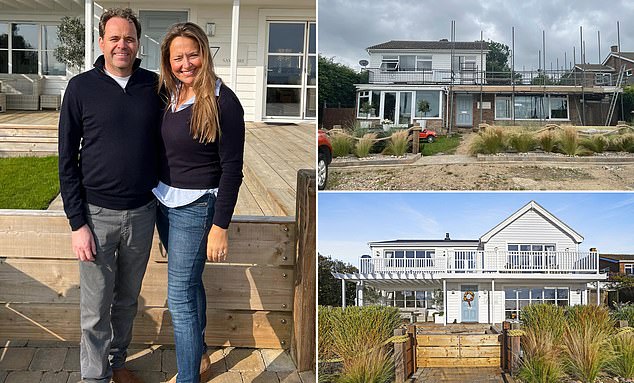
The British do love a fixer upper. We delight in the opportunity to gain more space or put our own mark on a property. But it was a brave soul who took on a project in the years following the pandemic. Global supply chain issues pushed up the cost of raw materials such as timber at a record pace. Building projects were frequently repriced two or even three times before they were complete as costs rose.
Homeowners struggled to find good builders with availability as high numbers of professionals left the industry – and the country, in some cases – during the pandemic. As a result, between 2020 and 2023, the cost of some home improvements leapt by more than 40 per cent, according to property portal Zoopla.
But, after years of rising prices and supply shortages, the frenzy is finally starting to cool.
Meanwhile, the alternative to renovating –moving home – remains eye-wateringly expensive and is set to rise further still.
The cost of moving has hit £12,187 for the average UK home costing £285,000, according to Compare My Move website. This includes £1,750 on stamp duty, £2,706 for conveyancing for buying and selling and £5,700 for typical estate agent fees. On a £1million home, the stamp duty alone would be £41,250. And from March, stamp duty bills will rise more.


Darren and Helen Taylor transformed a seaside cottage into a Hampton-style beach house
The amount that a purchaser can pay for a property before becoming liable for stamp duty will drop from its current temporary threshold of £250,000 to £125,000, and the threshold for first-time buyers will fall from the temporary threshold of £425,000 to £300,000.
So, is now a better time to improve than move? Wealth investigates how much it costs now to do up a property – and the renovations that are most likely to make your money back.
What is renovation market like now?
Qunatity surveyor Tim Phillips of Quantiv says it is much easier now to do a renovation than in the past couple years as prices are stabilising and the market has cooled. ‘Tradesmen’s lead times are down from nine months to two or three, and building merchants are less busy,’ he says.
Materials typically account for around half of any estimate. Pandemic supply chain issues and then Russia’s invasion of Ukraine sent prices rocketing, but they have since calmed. UK construction material prices in December last year were two per cent lower than the 12 months before, according to the Office for National Statistics. Nonetheless, prices were still 38.4 per cent higher than in January 2020.
However, Professor Noble Francis, economic director at the Construction Products Association, warns we’re not out of the woods yet. He says that material prices have been falling for seven consecutive months, but while the cost of some goods such as timber has dropped, ‘prices for kitchen furniture, metal doors and windows have been increasing’.
Attacks on Red Sea ships have tripled freight costs from China to Northern Europe, which is pushing up prices of some items such as electrics, white goods, fixtures and fittings. The cost of labour – which makes up the remaining 50 per cent of building costs – is also finally easing, says Prof Francis. ‘Construction wages in December 2023 were just 3.8 per cent higher than a year before,’ he says.
Architect Tomas Kinver, of Kinver Kreations, says he is finally seeing easing material and labour costs translating into lower estimates for aspiring renovators.
‘Projects are now coming in with lower price estimates from contractors than a year ago,’ he says.
The owner of a typical two-up-two-down mid-terrace house put a 40 square metre double-storey extension project on hold last year because estimates were coming in at £140,000 including VAT.
‘Estimates are now around £80,000 including VAT, so the owner is going ahead,’ Kinver says. He adds that the reduction is due to the drop in material costs as well as builders not needing to price up to anticipate unforeseen higher costs. Nearly half (47 per cent) of building companies reported a fall in enquiries for new work at the end of last year, according to the latest figures from the Federation of Master Builders.
So how much do renovations cost?
Anyone who has done a building project knows just how wildly costs can vary. Quotations often come in with price variations in the tens of thousands of pounds.
They depend on the availability of labour in a particular area and at that moment, which items are being hit by supply chain issues and the spec that you are targeting for the project.
For example, Matthew Boyd of Force 1 Construction in West Sussex says that a typical 4×8 metre single-storey kitchen-diner extension in his area could cost around £60,000 to £90,000. But, just one more expensive design choice – such as popular Crittall-style steel doors instead of bifold ones, can add thousands of pounds to the cost of the project. So coming up with even ballpark figures for the UK as a whole is a struggle – especially following a spell of huge price volatility. It costs around £1,500 to £2,250 for every square metre of internal space that you add to a property during a home renovation project, excluding VAT according to self builder and extender brand Homebuilding & Renovating.
That would mean that a 30 square metre kitchen extension would cost around £45,500 to £67,500.
But our snapshot of current price estimates demonstrates how much they can vary. Craig Colton, founder of Absolute Lofts, which operates in South-East England, says that a simple loft extension using Velux windows currently costs from around £30,000. A dormer extension is around £55,000, but the cost of fitting it out with a bathroom would be added on top of that.
‘A typical loft extension, which adds a bedroom and bathroom to a three-bedroom terrace or semi would cost around £60,000 to £65,000,’ he says. ‘But it would add around £100,000 to the value of such a home that is worth around £650,000, so the owner would recoup the money spent on it.’
PR agency owner Lisa Taylor, 38, has been getting quotes for a 12 square metre single-storey rear extension to her three-bedroom ex-council house in the village of Lodsworth, West Sussex.
She had to buy a fixer-upper to be able to afford to stay in the village where she had been renting. She and her husband bought the house last year for £410,000 and live there together with their daughter Freya, three.
‘Quotes for the rear extension, which would add a kitchen-diner with glass doors on to the garden came to around £50,000 to £60,000 all in, so we will need to save up first,’ says Lisa. ‘We are going to live here for ten years so we will hopefully make it back. I’ve seen ex-council houses that have been nicely renovated on sale at £750,000.’
Gareth Gazey, of Gazey Architects in London, says TV programmes such as Grand Designs have helped fuel an appetite for architect-designed extensions.
‘The popular glass side return (or side infill) extension on Victorian L-shaped houses typically costs £84,000 to £90,000, plus fees, in the South East,’ he says.
Matt Waller of building firm MW Residential, says that in his patch of south-west London, kitchen extensions tend to cost at least £100,000 including VAT – and that’s without the fancy fitted kitchen.
‘Some types of loft extension cost from around £120,000… and basement extensions from £200,000,’ he adds. Russell White of Winkworth estate agents in Putney, south-west London – says side-return infills can add £100,000 to a Victorian terraced house, while a loft conversion £120,000 to £150,000. Some estimates remain eye-wateringly high, even though price rises are subsiding overall.
Sarah Capes and husband Adam have moved into a four-bedroom house in Radlett, Hertfordshire, and looked into adding a double-height extension. ‘But the quote we got to do it was astronomical, £800,000, so we have decided to just live with what we have for now,’ says Sarah, who works in asset management.
Cut costs by doing it yourself
Darren and Helen Taylor spotted a seaview from a 1970s bungalow, and knew they could transform it into a Hamptons-style beach house. ‘We decided to do it all ourselves,’ says Darren, 51, who invests in property. ‘We knew we could add value just by building up on the flat roof – without groundworks,’ he says. ‘Building up is a much more cost-effective way of adding more square footage.’
Darren says they all learned on the job, with his 80-year-old dad Brian, a former builder, helping out, along with their son, Etienne, eight, who loved the hired digger.
Helen describes how they planned the layout by Tippexing out the walls on a printout of the floor plan. ‘It would have cost £500,000 if we had used builders.
‘We renovate to make money but also for the sense of achievement – turning ugly ducklings into swans,’ she says. The four-bedroom house, bought for £610,000 in 2019 is now for sale at £1.25 million through Jackson-Stops.
How much should you spend?
If you are renovating to live in a property for years to come, priorities are likely to be very different if you plan to fix up and move on.
If you are renovating to make a profit, you will need to focus on maximising the return on your investment and making sure that you are not spending more on the property than you could ever hope to achieve back.
Property investor Darren Mould of Domus Developments in Cambridge sold a four-bedroom house in Saffron Walden for £455,000, only a month after buying it at auction for £340,000. He gave it a £10,000 light makeover, including painting, new doors and electric and heating updates. ‘I could have done more to it, but my margin would have reduced,’ he says.
Those who plan to stay in the home for the long term may have to wait longer until they can afford to make improvements.
MW Residential’s Matt Waller says people have made improvements shortly after moving into a property, but that is not always the case in the current rates environment. ‘What has changed is that in our last six jobs, the owners have been in their homes for at least two years,’ he says.










